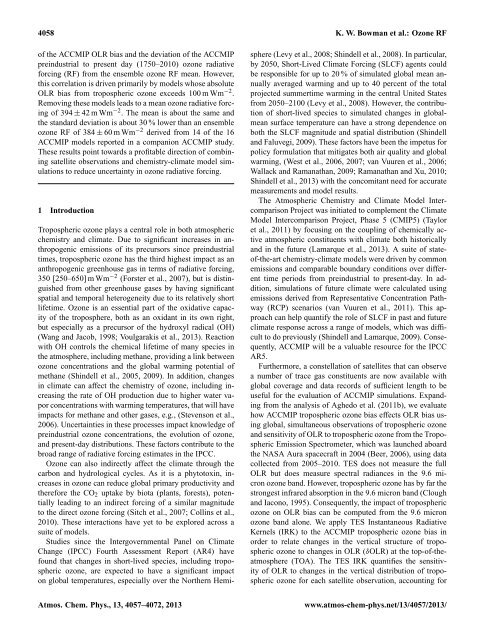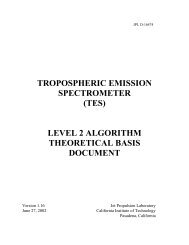Final Revised Paper - Atmospheric Chemistry and Physics
Final Revised Paper - Atmospheric Chemistry and Physics
Final Revised Paper - Atmospheric Chemistry and Physics
Create successful ePaper yourself
Turn your PDF publications into a flip-book with our unique Google optimized e-Paper software.
4058 K. W. Bowman et al.: Ozone RF<br />
of the ACCMIP OLR bias <strong>and</strong> the deviation of the ACCMIP<br />
preindustrial to present day (1750–2010) ozone radiative<br />
forcing (RF) from the ensemble ozone RF mean. However,<br />
this correlation is driven primarily by models whose absolute<br />
OLR bias from tropospheric ozone exceeds 100 m Wm −2 .<br />
Removing these models leads to a mean ozone radiative forcing<br />
of 394 ± 42 m Wm −2 . The mean is about the same <strong>and</strong><br />
the st<strong>and</strong>ard deviation is about 30 % lower than an ensemble<br />
ozone RF of 384 ± 60 m Wm −2 derived from 14 of the 16<br />
ACCMIP models reported in a companion ACCMIP study.<br />
These results point towards a profitable direction of combining<br />
satellite observations <strong>and</strong> chemistry-climate model simulations<br />
to reduce uncertainty in ozone radiative forcing.<br />
1 Introduction<br />
Tropospheric ozone plays a central role in both atmospheric<br />
chemistry <strong>and</strong> climate. Due to significant increases in anthropogenic<br />
emissions of its precursors since preindustrial<br />
times, tropospheric ozone has the third highest impact as an<br />
anthropogenic greenhouse gas in terms of radiative forcing,<br />
350 [250–650] m Wm −2 (Forster et al., 2007), but is distinguished<br />
from other greenhouse gases by having significant<br />
spatial <strong>and</strong> temporal heterogeneity due to its relatively short<br />
lifetime. Ozone is an essential part of the oxidative capacity<br />
of the troposphere, both as an oxidant in its own right,<br />
but especially as a precursor of the hydroxyl radical (OH)<br />
(Wang <strong>and</strong> Jacob, 1998; Voulgarakis et al., 2013). Reaction<br />
with OH controls the chemical lifetime of many species in<br />
the atmosphere, including methane, providing a link between<br />
ozone concentrations <strong>and</strong> the global warming potential of<br />
methane (Shindell et al., 2005, 2009). In addition, changes<br />
in climate can affect the chemistry of ozone, including increasing<br />
the rate of OH production due to higher water vapor<br />
concentrations with warming temperatures, that will have<br />
impacts for methane <strong>and</strong> other gases, e.g., (Stevenson et al.,<br />
2006). Uncertainties in these processes impact knowledge of<br />
preindustrial ozone concentrations, the evolution of ozone,<br />
<strong>and</strong> present-day distributions. These factors contribute to the<br />
broad range of radiative forcing estimates in the IPCC.<br />
Ozone can also indirectly affect the climate through the<br />
carbon <strong>and</strong> hydrological cycles. As it is a phytotoxin, increases<br />
in ozone can reduce global primary productivity <strong>and</strong><br />
therefore the CO 2 uptake by biota (plants, forests), potentially<br />
leading to an indirect forcing of a similar magnitude<br />
to the direct ozone forcing (Sitch et al., 2007; Collins et al.,<br />
2010). These interactions have yet to be explored across a<br />
suite of models.<br />
Studies since the Intergovernmental Panel on Climate<br />
Change (IPCC) Fourth Assessment Report (AR4) have<br />
found that changes in short-lived species, including tropospheric<br />
ozone, are expected to have a significant impact<br />
on global temperatures, especially over the Northern Hemisphere<br />
(Levy et al., 2008; Shindell et al., 2008). In particular,<br />
by 2050, Short-Lived Climate Forcing (SLCF) agents could<br />
be responsible for up to 20 % of simulated global mean annually<br />
averaged warming <strong>and</strong> up to 40 percent of the total<br />
projected summertime warming in the central United States<br />
from 2050–2100 (Levy et al., 2008). However, the contribution<br />
of short-lived species to simulated changes in globalmean<br />
surface temperature can have a strong dependence on<br />
both the SLCF magnitude <strong>and</strong> spatial distribution (Shindell<br />
<strong>and</strong> Faluvegi, 2009). These factors have been the impetus for<br />
policy formulation that mitigates both air quality <strong>and</strong> global<br />
warming, (West et al., 2006, 2007; van Vuuren et al., 2006;<br />
Wallack <strong>and</strong> Ramanathan, 2009; Ramanathan <strong>and</strong> Xu, 2010;<br />
Shindell et al., 2013) with the concomitant need for accurate<br />
measurements <strong>and</strong> model results.<br />
The <strong>Atmospheric</strong> <strong>Chemistry</strong> <strong>and</strong> Climate Model Intercomparison<br />
Project was initiated to complement the Climate<br />
Model Intercomparison Project, Phase 5 (CMIP5) (Taylor<br />
et al., 2011) by focusing on the coupling of chemically active<br />
atmospheric constituents with climate both historically<br />
<strong>and</strong> in the future (Lamarque et al., 2013). A suite of stateof-the-art<br />
chemistry-climate models were driven by common<br />
emissions <strong>and</strong> comparable boundary conditions over different<br />
time periods from preindustrial to present-day. In addition,<br />
simulations of future climate were calculated using<br />
emissions derived from Representative Concentration Pathway<br />
(RCP) scenarios (van Vuuren et al., 2011). This approach<br />
can help quantify the role of SLCF in past <strong>and</strong> future<br />
climate response across a range of models, which was difficult<br />
to do previously (Shindell <strong>and</strong> Lamarque, 2009). Consequently,<br />
ACCMIP will be a valuable resource for the IPCC<br />
AR5.<br />
Furthermore, a constellation of satellites that can observe<br />
a number of trace gas constituents are now available with<br />
global coverage <strong>and</strong> data records of sufficient length to be<br />
useful for the evaluation of ACCMIP simulations. Exp<strong>and</strong>ing<br />
from the analysis of Aghedo et al. (2011b), we evaluate<br />
how ACCMIP tropospheric ozone bias effects OLR bias using<br />
global, simultaneous observations of tropospheric ozone<br />
<strong>and</strong> sensitivity of OLR to tropospheric ozone from the Tropospheric<br />
Emission Spectrometer, which was launched aboard<br />
the NASA Aura spacecraft in 2004 (Beer, 2006), using data<br />
collected from 2005–2010. TES does not measure the full<br />
OLR but does measure spectral radiances in the 9.6 micron<br />
ozone b<strong>and</strong>. However, tropospheric ozone has by far the<br />
strongest infrared absorption in the 9.6 micron b<strong>and</strong> (Clough<br />
<strong>and</strong> Iacono, 1995). Consequently, the impact of tropospheric<br />
ozone on OLR bias can be computed from the 9.6 micron<br />
ozone b<strong>and</strong> alone. We apply TES Instantaneous Radiative<br />
Kernels (IRK) to the ACCMIP tropospheric ozone bias in<br />
order to relate changes in the vertical structure of tropospheric<br />
ozone to changes in OLR (δOLR) at the top-of-theatmosphere<br />
(TOA). The TES IRK quantifies the sensitivity<br />
of OLR to changes in the vertical distribution of tropospheric<br />
ozone for each satellite observation, accounting for<br />
Atmos. Chem. Phys., 13, 4057–4072, 2013<br />
www.atmos-chem-phys.net/13/4057/2013/





